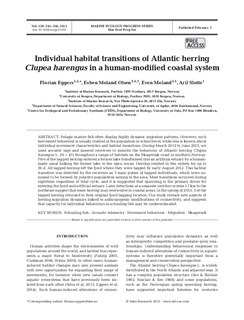| dc.contributor.author | Eggers, Florian | |
| dc.contributor.author | Olsen, Esben Moland | |
| dc.contributor.author | Moland, Even | |
| dc.contributor.author | Slotte, Aril | |
| dc.date.accessioned | 2015-03-02T13:31:04Z | |
| dc.date.available | 2015-03-02T13:31:04Z | |
| dc.date.issued | 2015 | |
| dc.identifier.citation | Eggers, F., Moland Olsen, E., Moland, E., & Slotte, A. (2015). Individual habitat transitions of Atlantic herring Clupea harengus in a human-modified coastal system. Marine Ecology Progress Series, 520, 245-256. doi: 10.3354/meps11103 | nb_NO |
| dc.identifier.uri | http://hdl.handle.net/11250/278148 | |
| dc.description | Published version of an article from the journal: Marine Ecology Progress Series. Also available from Inter Research. Http://dx.doi.org/10.3354/meps11103 | nb_NO |
| dc.description.abstract | Pelagic marine fish often display highly dynamic migration patterns. However, such movement behaviour is usually studied at the population or school level, while less is known about individual movement characteristics and habitat transitions. During March 2012 to June 2013, we used acoustic tags and moored receivers to monitor the behaviour of Atlantic herring Clupea harengus L. (N = 47) throughout a range of habitats on the Skagerrak coast in southern Norway. Five of the tagged herring entered a former lake transformed into an artificial estuary by a human-made canal linking the former lake to the open ocean. Herring resided in this system for up to 36 d. All tagged herring left the fjord where they were tagged by early August 2012. This habitat transition was detected by the receivers as 3 main pulses of tagged individuals, which were assumed to be formed by putative populations mixing in the area. Most transitions occurred during nighttime regardless of tidal cycle, and it is suggested that spawning is the primary driver for entering the fjord and artificial estuary. Later detections at a separate receiver system 17 km to the northeast suggest that some herring may overwinter in coastal areas. In the spring of 2013, 3 of the tagged herring returned to their original fjord tagging location. Our study reveals new aspects of herring migration dynamics linked to anthropogenic modifications of connectivity, and suggests that capacity for individual behaviours in schooling fish may be underestimated. | nb_NO |
| dc.language.iso | eng | nb_NO |
| dc.publisher | Inter Research | nb_NO |
| dc.title | Individual habitat transitions of Atlantic herring Clupea harengus in a human-modified coastal system. | nb_NO |
| dc.type | Journal article | nb_NO |
| dc.type | Peer reviewed | nb_NO |
| dc.subject.nsi | VDP::Agriculture and fishery disciplines: 900::Fisheries science: 920 | nb_NO |
| dc.source.pagenumber | 245-256 | nb_NO |
| dc.source.volume | 520 | nb_NO |
| dc.source.journal | Marine Ecology Progress Series | nb_NO |
